Hop Breeding (2015)
Wednesday, February 11th, 2015
You may want to start by reading: Growing hops from seed, Hop Breeding (2014), Breeding results 2014
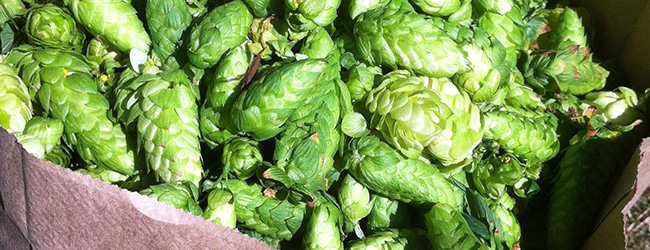
During fall of 2014, we collected thousands of seeds from the two hop yards. The individual flowers had been pollinated by hand and carefully isolated to ensure parentage. In total, we collected nearly 40 crosses:
Male/pollen source:
- NHB002 (wild male)
- NHB005, NHB007, NHB017 (magnum x cascade)
- NHB019 (magnum x chinook)
Females:
- Cascade
- Chinook
- Nugget
- Pride of Ringwood
- Sterling
- Willamette
- Mt Hood
- Galena
- NHB003 (neomexicanus)
- NHB006 (magnum x cascade)
- NHB025 (magnum x chinook)
- NHB027 (open pollinated cascade)
2-09
After several months of cold stratification (damp perlite at 40F), some of the seeds were placed in a germination chamber. This year We are trying a soilless mix: 50% coir + 50% vermiculite + a pinch of phosphate. The temperature was set near 85F.
2-11
The seeds have started to pop – 13 so far.
2-15
3-05
3-16
80 have been potted up. Unfortunately, they are already starting to out-run the containers.
4-10
Finally moved the hops outside!
The new hop yard is on a steep slope and presented several challenges to build. Over several days, we dug holes, erected posts, set ground anchors, and tensioned trellis cable. This weekend we found ourselves planting the hops using flashlights, since the sun had already set after a long day of work. I can’t thank Joe enough. Not only is he allowing me to use his yard, but he was out there everyday working to make this possible.
Next steps:
- Strings need to strung ASAP
- I need to document the crosses and position of all hops
- Start culling males as they appear
4-19
The strings are in place and the drip system is set!
On first inspection the hops looked really beaten up. There had been a hail storm shortly after planting, then a week of hot sun. Looking closer though, most had new growth. Only about 6 looked really bad, but we left even those ones for now.
One thing that is now obvious is the need for more compost.
5-17
Checked on the hopyard… The hops still look a little beaten, but some are starting to take off. Several are already over my head. Other, whose main bine was damaged, have started popping out new bines from the soil. Only 6 seemed completely dead. Another load of compost was added to help them along.
- 2 x Cascade
- 16 x Chinook
- 13 x Galena
- 7 x Magnum/Cascade
- 4 x Magnum/Chinoook
- 30 x Nugget
- 6 x Pride of Ringwood
- 1 x Sterling
Males:
- 20 x EV02
- 23 x MxCas01 (NHB005)
- 13 x MxCas03 (NHB007)
- 18 x MxCas13 (NHB017)
- 4 x MxChin01 (NHB019)
7-06
On the 4th, we visited the other hop yard, where all the first-year plants are. I was pleasantly surprised. About a dozen plants are showing burrs. A few have small cones already forming. The nugget, chinook, and galena crosses seem to be ahead of the pack in terms of size and maturity – but it really varies from plant to plant (as expected).
8-09
We stopped by the hop yard to check on the first-years. Out of the 78 original plants: 10 died and 12 males were culled. The remaining 56 plants are all female. Some are still covered with burrs, while others have fully developed cones.
There is also one special plant that I have been keeping my eye on. From the start, the leaves have been a bit different than all the rest – elongated and heavily toothed. There are also a number of leaves with two lobes (rather than the typical, 1,3,5 configuration).
I thought the plant might grow out of it, but the phenotype is still going strong in this one. So, I was especially excited to see burrs, confirming that she is a female.
9-20
Finally got around to the hops in the first-years yard.
Most were past prime for brewing, but our main goal was to pick the plants that will continue on for next year. A little less stringent than last year – we simply judged based on the cone size, compactness, scent, the amount of cones, and plant health. Unfortunatly, the crosses did so well that we had trouble culling 90% as hoped. Instead, we decided to continue with 26 for next year:
- Chinook ♀ x (Magnum x Cascade) ♂ – 7 plants
- Nugget ♀ x Neomexicanus (EV02) ♂ – 7 plants
- Galena ♀ x (Magnum x Cascade) ♂ – 4 plants
- POR ♀ x (Magnum x Cascade) ♂ – 3 plants
- Nugget ♀ x (Magnum x Cascade) ♂ – 2 plants
- (Magnum x Cascade) ♀ x (Magnum x Cascade) ♂ – 2 plants
- (Magnum x Chinook) ♀ x (Magnum x Chinook) ♂ – 1 plants
It was surprising to see how many Nugget x Neomexicanus crossed made the cut. These plants had consistently large cones with strong citrus/spice scent.
Data
NHB = Nagmay Hop Breeding. 001-004 are from 2013, 005-046 are from 2014.
- Full breeding spreadsheet (now public for all to see)
- Hop lineage family tree

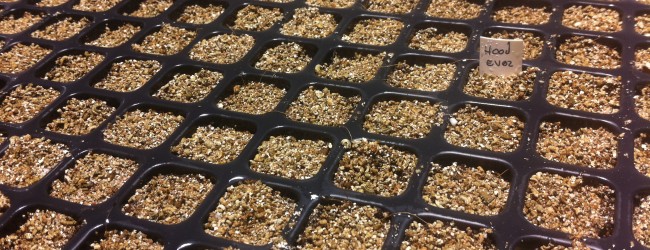
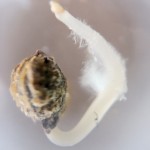

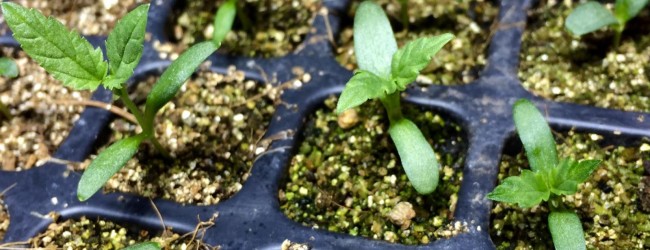
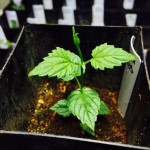

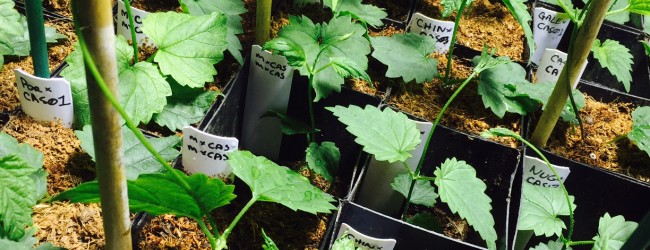
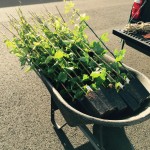
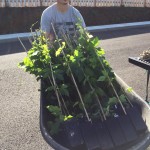


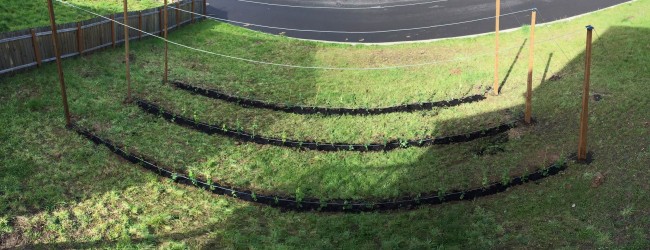
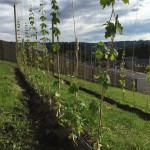

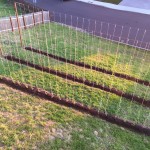
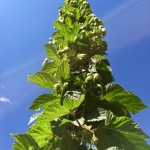
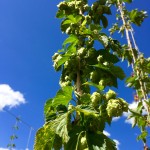

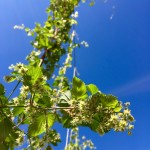
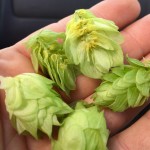
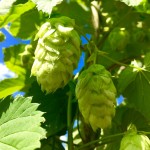


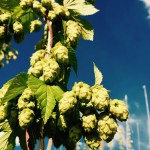
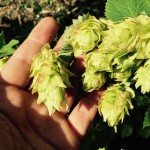
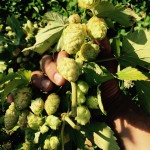
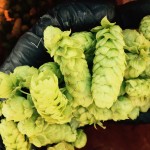
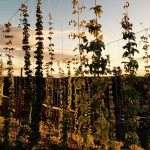
Steven Hill Says:
Hey! Cool stuff, one question, how did your double female crosses produce male progeny? While the structural genes for male flowers are not on the Y-chromosome, expression of male flower genes relies heavily on the y chromosome. Id look into flow cytometry or light sequencing to check for Y-chromosome markers. If you have true males with female sex chromosomes that’d be quite the find!
nagmay Says:
Steven,
“how did your double female crosses produce male progeny?”
Out of the 42 seedlings resulting from the female crosses, there were no “true males”. However, 5 plants did produce limited amounts of male flowers when heavily stresses. The other 37 remained female regardless of the outside factors.
These hermaphrodites were all culled, but pollen was collected – we had no way to know if they would be fertile. Surprisingly, two of the five did, in fact, pollinate the generation seen in this post. Which, as you can see, resulted in a larger male population.
Unfortunatly, I don’t have access to flow cytometry or light sequencing.
Steven Hill Says:
It’s not surprising to see no males in a small population, but it is interesting that downstream you ended up with a male population.
I’d be *very* hesitant to claim that they are indeed progeny from a female only line, especially without checking for any of the established male markers. Hop pollen is very lightweight and is known to travel long distances.
In the 80’s and 90’s quite a bit of work was done on sex expression in Hop. See “Sexual development and sex chromosomes in hop” by Shepard and Darby. There is more specific characterization that has gone on at Oregon State and the USDA, but this material isn’t available online yet (working on it).
In vivo we have no evidence that a male can exist without Y-chromosomes. Although it is common for a true female to throw male flowers, even in OP crosses you don’t see cross pollination from females. We just submitted a paper that looked across over 600 cultivars world wide, every male had substantial evidence of the y-chromosome, where as no female had any evidence of a Y.
We have however observed the opposite, if you cross a wild japanese type hop (var cordifolious) with a “normal” hop, you can get true males that appear female. But this is due to the differences in sex chromosomes between cordifolious and other hop subspecies.
nagmay Says:
Steven,
I am, of course, open to the possibility that the results aren’t as they appear. However, we were quite careful with the initial pollination and no flowers in the rest of the yard produced any seed – so, OP seems unlikely.
An alternative that I have considered is that the original donor was not, in fact, female. Even though, by all indications the pollen came from a Magnum plant that had been producing female flowers for many years.
I do wish that I had the equipment to dive into it further. Let me know when your research is available for the public – I would love to read it. Feel free to contact via email with any other questions gabriel@nagmay.com
nagmay Says:
Also, I am very interested to hear more about your Humulus japonicus experiments. I was unaware that it was even possible to cross them with lupulus. What did the flowers look like?
Steven Hill Says:
Sorry I didnt answer the second part, Humulus lupulus cannot be crossed with japonicus. I was referring to Humulus lupulus var cordifolious, which has a 2n=16 X1X2Y1Y2 karyotype.
gabriel nagmay (dot com) | Archive » Hop Breeding (2016) Says:
[…] You may want to start by reading: Growing hops from seed, Hop Breeding (2014), Breeding results 2014, Hop Breeding (2015) […]
James Says:
What type of soil mixture do you use for the pots? They look much more healthy than my sprouts did.
nagmay Says:
James,
I tend to mix my own starter mix. It is mostly sand, coir, perlite, and base fertilizers.
Raphael Hannart Says:
Hello :)
I hope this email finds you well and in good health.
I am a small organic wine producer based in the Mosel Valley / Luxembourg and I am looking for some hops plants or seeds NATIVE FROM NEW ZEALAND :) – organic certified if possible – to grow in our Happy Duchy organic vineyards here in Luxembourg :)
Would you have any for sale and which variety/varieties please ?
Do you have a list of your hops plants / seeds for sale please ?
When can I order them ?
Kindest regards
Raff
Raphaël Hannart
Happy Duchy – Family Estate
nagmay Says:
Raff,
Nope – no New Zealand hops here. Best of luck and let me know if you find a source.
Bill Reeves Says:
I have 2 common hop females but no male. I cut some male flowers from elsewhere and hung them near the females to try and get some fertile flowers. Is there any way to tell if this worked? Some of the female cones have a few brown thin short ‘hairs’ sticking out from parts of the cones. Would this indicate fertilized flowers?